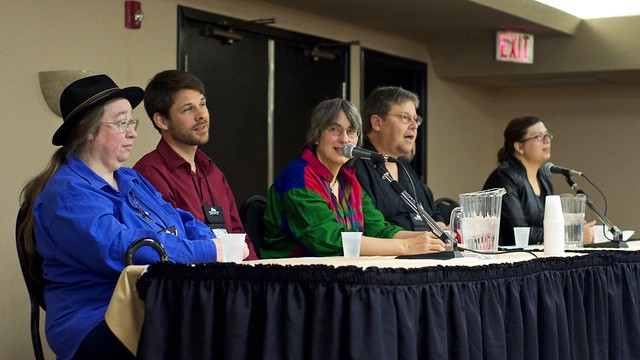Herewith my writeup of the “Maps and Fantasy Literature” panel at the World Fantasy Convention earlier this month in Richmond Hill, Ontario, based on fragmentary and cryptic notes and no doubt full of misrepresentations and misattributions. The panel took place on Sunday, November 4 at 10 a.m. Panellists were Robert Boyczuk, Laura Goodin, Matthew Johnson, Sara Simmons, Jo Walton, and Bill Willingham (who acted as moderator). The panel description:
“I absolutely refuse to leave until we are able to take back something in the nature of a chart.” (Arthur Conan Doyle: The Lost World) A discussion of the history and design of maps used in fantasy novels, either as endpapers or within the stories themselves. What revealing details do maps add–for readers and writers–to the description, look, and feel of realms that never were? What delights do they add to the landscape of the imagination? Which books depict their unknown lands with the sureness of a Captain Cook, and which imaginary lands do you most wish we had maps of?
Some of the panellists began by explaining their take on maps: Bill liked them but thought they could create problems in a book; Laura hated bad maps; Matt loved them in principle but hated them in execution. Jo agreed, and at length: she described herself as “pro good map, anti bad map.” She was opposed to the “obligatory” map, the map that was there to tell you that it was a certain kind of fantasy book. She objected to absurd maps of ridiculous geographies, like cities in swamps: “I hate that; it’s stupid,” she said. She also argued that a book that makes you turn to the map while reading it has done something wrong.
There was some discussion of Diana Wynne Jones’s Tough Guide to Fairyland (which argues that quest fantasies visit “every damn place” shown on the map), and whether maps should show places that never appear in the text. Are they filler, or do unvisited places provide verisimilitude?
On the other hand, Matt argued that fantasy maps are too much like modern maps—too accurate—and too little like medieval maps, where the further out you went, the more fanciful the maps became.
A similar line of argument is in the idea of the unreliable narrator and relating that to maps. Jo mentioned Patrick Rothfuss’s novels, which have a map as unreliable as their narrator: “Nothing that you want to know where it is is on it!” Rothfuss is, she said, deliberately playing with your expectations.
Another line of argument was over whether having a map was too constraining for an ongoing narrative. This was something Bill had explained to him in the context of comic book writing. It was also something Fritz Leiber also apparently believed: having a map would paint yourself into a corner.
John Clute cut in from the audience to mention a forthcoming book about fantasy maps whose title and author escaped him. I filled it in for him (as you might have predicted): it’s Stefan Ekman’s Here Be Dragons. He was dead excited about it.
Toward the end of the panel there was a discussion of distances, real and psychological. Matt noted the difference in travel time between the medieval and the modern, which is to say that one did not travel great distances lightly, quickly or often. Jo argued it wasn’t a just a medieval vs. modern thing: the number one thing North American writers get wrong about Britain is the psychological distance. Even today, a five-hour drive in the U.K. is not something taken lightly, whereas in North America it’s nothing.
There was much more, but I made the mistake of listening to them rather than writing them down—one of the risks of being so familiar with what was being discussed. Suffice to say that as someone who knows a thing or two about fantasy maps, I was not disappointed.

